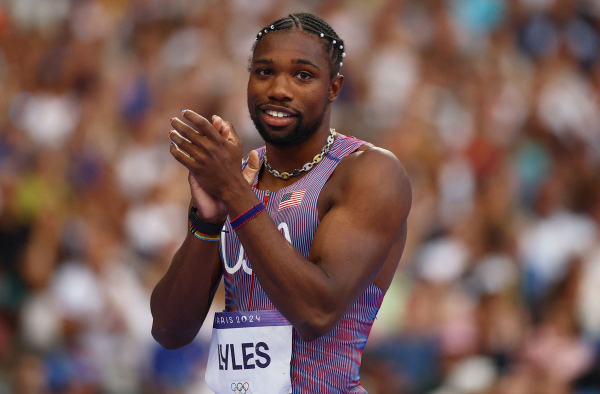Gabby Thomas may be a star on the track and financially secure now, but her college experience was far from glamorous. Long before NIL changed the game for student-athletes, Thomas faced the harsh reality of balancing elite competition with financial struggles. Sure, today’s athletes can sign endorsement deals, land sponsorships, and make money through social media, but back then? Not a chance. Before 2021, the NCAA’s strict amateurism rules banned athletes from earning anything beyond scholarships. So while Thomas was out there flying on the track, her wallet was barely crawling. Things got so tight, that she even had to borrow five bucks just to buy a meal.
It all started after turning professional. Well, we know she joined Harvard University in 2015, majoring in neurobiology and global health, and while that sounds impressive (because it is), Harvard’s price tag was just as jaw-dropping. Hundreds of thousands of dollars over four years with no athletic scholarships. “Harvard doesn’t do scholarships,” she put it bluntly. So, while some college athletes got tuition covered, Gabby Thomas had to juggle an Ivy League education, elite competition, and a serious financial burden. But then…
She graduated in 2019! Two years before NIL changed everything. No endorsement deals, no sponsorships, no social media earnings – just pure hustle. Fast forward to 2024, and with a net worth between $1 million and $5 million, she’s doing just fine. But what if NIL had been around back then?
That’s exactly what she tackled in a recent appearance on the YouTube channel Your Rich BFF, where she sat down with Vivian Tu, the channel’s founder and CEO. Tu wasted no time, hitting her with a question that got right to the heart of it: “How do you think your experience would have been different if you were five years younger and went to college during the NIL era”

Gabby Thomas had plenty to say. “Gosh, I mean, so different! The NIL is crazy I could have never imagined that,” she admitted. For Thomas, NIL would have been a financial lifesaver, easing the stress of balancing elite competition with everyday expenses. She recalled struggling to make ends meet during track meets, sometimes even borrowing five bucks from friends just to afford a meal. “I had to, like, ask my friends sometimes, ‘Oh, could I borrow five bucks so we can afford the salad?’ Because I didn’t have it, and so that was really stressful,” she said.
With the NCAA’s allotted food stipend often falling short and Harvard not offering athletic scholarships, money was always tight. “Harvard doesn’t do scholarships,” she pointed out, clarifying that any extra financial support would have been a game-changer. At the same time, Thomas isn’t sure she would have been ready to handle brand deals as a teenager if NIL had been around. “I don’t want to see those memories when Facebook brings them back up!” she joked, wondering what freshman-year Gabby would have been posting while trying to build a brand.
Would she have leaned into fashion and advocacy earlier? Maybe. Would she have picked the right partnerships? Who knows? “I’m not sure if the brands I partner with now would have been a good fit back then or what would have happened,” she admitted, recognizing that growing into her career organically may have worked in her favor. In the end, Gabby Thomas feels everything turned out for the best. Her brand partnerships feel authentic, and she’s in a solid financial position. But is it enough?

Track and field may bring in endorsements, but does it truly provide the financial security needed to compete at the highest level, especially for an Olympic athlete? Training, coaching, travel, and recovery all come with a hefty price tag, and the financial burden of chasing Olympic glory isn’t always talked about. In the same interview, Gabby pulled back the curtain on the harsh reality of what it costs to be an elite athlete.
Gabby Thomas’ Olympic dream came at a cost
Tokyo 2020 was Gabby Thomas’ first Olympics, but getting there wasn’t just about training hard! It came with a hefty price tag. Before the sponsorships and medals, her parents had to invest between $50,000 to $100,000 just to help her chase her Olympic dream. “You have to pay a coach, you have to pay an agent, you have to pay for your travel to meets, massage therapists, access to a weightlifting facility,” Thomas explained. And unlike major sports leagues, professional track doesn’t come with a guaranteed salary.
“Thankfully, I had sponsors by the time I graduated,” she added. But before that? It was a financial uphill battle. Fast forward to today, and Thomas is not just a sprint queen—she’s a Harvard graduate, a medical professional, and now a five-time Olympic medalist. At the Paris Olympics, she left no doubt about her dominance, storming to three gold medals in the 200m, 4x100m, and 4x400m relays.
But her journey raises a bigger question: If one of the best in the world had to rely on her family’s support, what about the next generation of track stars? Is the cost of chasing Olympic glory becoming too high? Comment below and let us know your views on it!
The post Voicing NIL Disappointment, Gabby Thomas Reflects on Track and Field Career’s Financial Struggles: “Crazy” appeared first on EssentiallySports.



